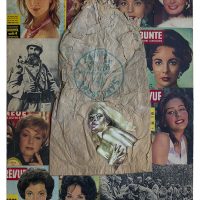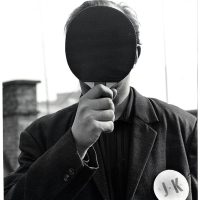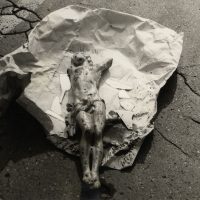Gábor Attalai: Negative Star, 1970, black-and-white photograph, 392 x 301 mm © Marinko Sudac Collection
Stano Filko: Pink Tank, Remembering HAPPSOC, 1968, black-and-white photograph, paint, 300 x 146 m © Marinko Sudac Collection
Tomislav Gotovac: Untitled (Revue), 1965, collage, cardboard, 1253 x 853 mm © Marinko Sudac Collection
Július Koller: Ping-Pong, J.K., 1970, black-and-white photograph, 178 x 161 mm, photo by Milan Sirkovský © Marinko Sudac Collection
Group of Six Authors: Exhibition-action on the Republic Square, Zagreb, 25. 10. 1975, 1975, black-and-white photograph, 90 x 141 mm © Marinko Sudac Collection
Curated by Marco Scotini and presented first at the FM Centro per l’Arte Contemporanea (Milan, Italy) in autumn 2016, the exhibition develops its narrative based on the Marinko Sudac Collection (Zagreb, Croatia), one of the conceptually most complete Eastern-European private collections, which preserves not only works of art but also entire archives and documentary materials of historical importance. The collection—which gave birth to a research institute and other big-scale projects as well—has set itself the task of retracing radical artistic trends within a coherent avant-garde line in the area between the Iron Curtain and the Soviet Union. By including a considerable amount of documents, the curator’s intention was to create an archival background to culturally embed the evolution of the displayed artistic narratives. Artists in many cases used documents as mediums, hence these materials tightly connect to their activity and help understanding the “invisible web” connecting the different parts of the region.
The curator approaches this chapter in art history as anything but marginal, which cannot be reduced to a product either of Soviet or Western influence. In former Yugoslavia, the synchroneity of East and West resulted in an autonomous artistic language equivalent to that of Western Modernity. Is it possible to interpret this scenario as a unique example of a “Socialist Modernism”? Can we challenge the canonization of hegemonic art history and its assumptions of universalism, neutrality, and aesthetic autonomy, thus revealing a multiplicity of local Modernities that are diverse according to each geopolitical context? The exhibition tries to give an answer to these questions. Rereading the artistic scene of former Yugoslavia effectively means facing a constitutive and unshakeable cultural difference.
Former Yugoslavia was the first region to reject the Stalinist doctrine from its cultural policies, making abstract art one of its main languages already in the Post-War period (Vojin Bakić, EXAT 51, Gorgona, etc.). Conceptual art, too, became more politically critical, flourishing not only in Zagreb but also in cultural centers like Ljubljana, Belgrade, or Novi Sad. Urban interventions, performances, and videos are at the center of the collective practices of OHO, the Group of Six Authors, Bosch + Bosch, Kôd Group, or Verbumprogram. The individual achievements of several artists have, by now, reached international recognition, e.g. Sanja Iveković, Marina Abramović, Mladen Stilinovic, Goran Trbuljak, Tomislav Gotovac, Katalin Ladik, Vlado Martek, Radomir Damnjanović Damnjan.
The exhibition, on the one hand, connects the scenes of former Yugoslavia with nonconform initiatives from Hungary, former Czechoslovakia, and Poland, through the works of artists like Miklós Erdély or the activity of the Pécs Workshop, Julius Koller or Stano Filko, or Natalia LL and Andrzej Lachowitz. On the other hand, it retraces independent art spaces that functioned as driving forces for artistic groups and individual expressions not wanting to align with the official discourse.




